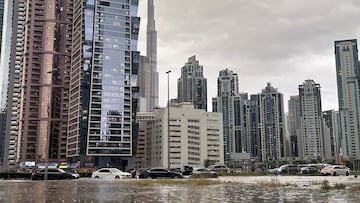What is cloud seeding? Did cloud seeding make the Dubai flooding worse?
The UAE has been using cloud seeding since the 1990s to increase rainfall. Some are wondering if it is behind the historic flooding that hit Dubai.

The technique of cloud seeding has been around since the 1940s. It has been employed in a number of states in the US and several other countries around the world.
This weather modification technique is seen as a promising way of producing more precipitation in places that suffer water shortages. However, others find it controversial and see those employing it as “playing God”. Some have questioned whether it was behind the historic flooding that swamped Dubai.
Dubai airport and much of Dubai are underwater and some are suggesting it's the result of over-aggressive cloud seeding to promote rainfall. https://t.co/G032tqXQez
— Evan Dyer (@EvanDyerCBC) April 16, 2024
What is cloud seeding?
Clouds form when water vapor in the atmosphere cools and condenses around tiny particles, dust or ice nuclei, floating in the atmosphere. When the tiny water droplets or ice crystals that develop become too heavy, they fall to the Earth in the form of precipitation.
Cloud seeding is the process adding more of these particles into a cloud thus improving its ability to produce precipitation. Common agents include “silver iodide, liquid propane, dry ice (solid carbon dioxide), and various salt compounds” according to the North American Weather Modification Council (NAWMC).
The particles can be introduced into the clouds either from the ground or flying planes into clouds. However, the atmospheric conditions need to be correct, not every cloud will be conducive to developing precipitation nor the desired type be it snow or rain.
When properly applied, cloud seeding, “can produce precipitation increases up to 10% or greater.” But it can also be used to reduce the size of hailstones to protect property and crops as well as suppress fog around airports to improve visibility and safety for aircraft.
Meteorologists monitor the weather and safety precautions are taken during cloud seeding in the United States to avoid problematic situations. These include avoiding creating excess precipitation when there is a high risk of flooding or the snowpack has reached a certain threshold.
Dubai's cloud seeding command Center pic.twitter.com/yrQ9QjZk90
— Learn Something (@EducationalFeed) April 9, 2024
Did cloud seeding make the Dubai flooding worse?
The United Arb Emirates has been working with cloud seeding since the 1990s. The National Center of Meteorology (NCM) is the government agency that oversees the country’s Rain Enhancement Program. Using dozens of weather stations it closely monitors atmospheric conditions to manage seeding operations.
Planes are flown into the clouds deemed to be the most promising where they unleash seeding agents to encourage precipitation. The UAE has been experimenting with three different approaches in a recent field campaign carried out last fall. These included Nanomaterial Seeding, Large Salt Particle Seeding, and Conventional Hygroscopic Flares, according to the Emirates News Agency.
Related stories
Ahmed Habib, a specialist meteorologist NCM, told Bloomberg that seeding planes carried out seven missions over two days prior to the heavy downpours that inundated portions of the desert nation. This led some to blame the once in one-hundred-year event on the weather modification technique.
While it may have been partially responsible, other atmospheric conditions could well have played a bigger role. Meteorologist Jeff Berardelli pointed out that there was an excessive amount of dust from the desert suspended in the air when the rain bomb moved over Dubai. That dust also acts as a cloud seeder leading him to question if man-made seeding could really be blamed for the deluge.



Complete your personal details to comment